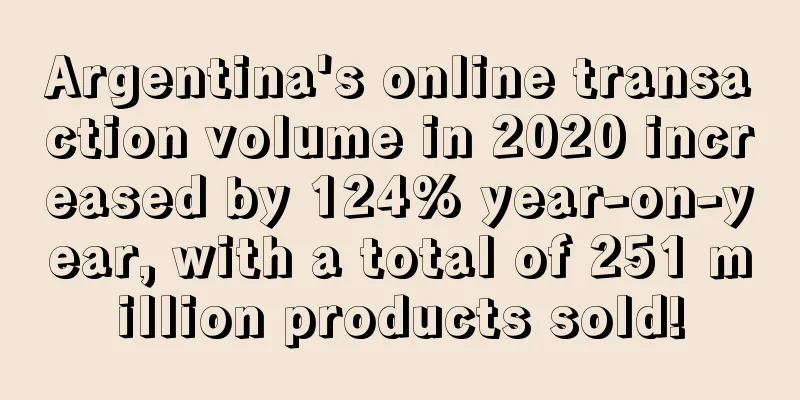Crazy! Another e-commerce giant's annual revenue exceeds 200 billion

|
The increasing development of science and technology and the increase in Internet penetration have driven 2.77 billion people around the world to shop online. Under this trend, global e-commerce sales have soared and are expected to exceed US$6.8 trillion (about RMB 49.3 trillion) by 2025.
Among many markets with huge potential, Russia is developing at an astonishing speed and has become a new force that cannot be ignored in the global e-commerce field. One seller said: "The next blue ocean of cross-border e-commerce is in Russia!"
Looking at the platforms in the blue ocean market, Ozon, known as the "Russian Amazon", as a local e-commerce giant, has recently delivered a beautiful report card, which is truly amazing!
The annual GMV of "Russian Amazon" reached 2.875 trillion rubles
According to information, Ozon is the oldest e-commerce platform in Russia with the widest product range. It was once called the "Russian Amazon" by Bloomberg .
Recently, the number one player in the Russian e-commerce market released its performance report for the fourth quarter and full year of 2024.
Let’s talk about the whole year first. Data shows that in 2024, the total GMV of the Ozon platform reached 2.875 trillion rubles (about 233.4 billion yuan), a year-on-year increase of 64% . The adjusted EBITDA turned from loss to profit, breaking through the 40 billion ruble mark.
The total revenue for the whole year of 2024 increased by 45% year-on-year to 615.7 billion rubles (about 49.99 billion yuan); the gross profit was 99.9 billion rubles, an increase of 126% year-on-year; and the adjusted EBITDA was 40.1 billion rubles.
Professionals pointed out that Ozon's growth far exceeded market expectations. This data confirms that the Russian e-commerce market has huge development potential. At the same time, this achievement has also had a positive impact on e-commerce and financial technology.
In addition, looking at the fourth quarter of last year alone, Ozon's performance was also impressive.
In the fourth quarter of 2024, Ozon's total revenue increased by 69% year-on-year to 216.6 billion rubles (about 17.581 billion yuan) ; gross profit was 35.7 billion rubles (about 2.909 billion yuan), a year-on-year increase of 2.6 times ; adjusted EBITDA reached an all-time record of 16.8 billion rubles , an increase of 15.4 billion rubles year-on-year .
The financial report also predicts that by 2025, the GMV of the Ozon platform will increase by 30-40% , and EBITDA will reach 70-90 billion rubles.
Faced with multiple containment measures from the West, pressure on local consumption, inflation and other unfavorable factors, the Ozon platform has continued to soar against the trend and achieved such outstanding results. This is inseparable from the rapid development of the Russian e-commerce market and the change in consumer shopping behavior.
Data from the Russian Association of E-Commerce Enterprises ( AKIT) shows that the potential of the region's e-commerce market had been released long before the Russia-Ukraine conflict.
In 2010, its scale was only 260 billion rubles (about 21.19 billion yuan), and by 2022 it had soared to 498.6 billion rubles (about 406.359 billion yuan), with a compound annual growth rate of about 27.91%, far exceeding the global average of 14.28%.
It is worth mentioning that in 2024, the scale of Russia's e-commerce market did not shrink under the influence of the Russia-Ukraine conflict, but achieved a new breakthrough. Data shows that last year its scale reached 1187.73 billion rubles (about 967.99 billion yuan), and the growth rate far exceeded the global average.
Based on this, some sellers pointed out that "in the future, the potential of the Russian e-commerce market will continue to explode, and it may be a new trillion-dollar outlet for cross-border e-commerce!"
On the other hand, the rapid development of the e-commerce market has led to a rapid increase in the number of online shoppers.
Among Russia's total population of more than 140 million, there are more than 130 million Internet users, with an Internet penetration rate of 90.4%. Among them, Ozon is the preferred online shopping platform for most consumers.
Last year, Ozon added 10.4 million active buyers, bringing the total number of users to 56.5 million, which means that about one in three Russians uses the platform , which shows its popularity in the country. Moreover, these users place an average of 26 orders per year, pushing the platform's annual order volume to nearly 1.5 billion.
Ozon has been on a rapid rise and is not only the preferred shopping platform for many consumers, but has also attracted the attention of cross-border sellers.
Ozon's policies continue to benefit Chinese cross-border sellers
With strong growth, consumer demand in the Russian market and local e-commerce platforms such as Ozon has gradually expanded, which has attracted widespread attention from Chinese sellers.
Up to now, China has been Russia's largest trading partner for more than 10 years. According to data released by the General Administration of Customs, in 2024, the trade volume between China and Russia reached US$244.8195 billion, a year-on-year increase of 1.9%, setting a new record again . Among them, China's exports to Russia increased by 4.1%, with a total of US$115.4992 billion.
As the largest local e-commerce platform in Russia, Ozon naturally followed market trends and turned its attention to Chinese sellers.
In June last year , the total number of sellers on the Ozon platform was about 500,000, of which more than 100,000 were Chinese sellers, accounting for at least 20%. Compared with 10,000 in 2022, this has increased tenfold, far exceeding expectations. At the end of last year, the number of Chinese sellers on the platform and the sales from Chinese sellers reached new heights.
Since the beginning of this year, Ozon has launched a series of new policies to benefit every seller in order to reduce operating costs, simplify operational processes and expand market opportunities.
First, Ozon adjusted the SKU quota calculation logic. Previously, new stores could only list 500 SKUs, and the products that were removed from the shelves and archived would also occupy the SKU quota. Now, the removed and archived products no longer occupy the quota, which will give sellers more opportunities to test products in the future.
Secondly, one business license can be used to register multiple stores on Ozon. The previous policy was one license per store, which was not friendly to sellers with multiple stores. After the new regulations are implemented, the cost of sellers opening new stores will be greatly reduced.
In addition, last month, Ozon also announced that new sellers no longer need to pay a deposit when registering. It is reported that before this policy, Ozon's deposit was as high as 2,400, but now it has been directly cancelled, which is a great benefit to new sellers.
Most importantly, Ozon has been expanding new sites. Currently, the platform's sites include Russia, Kazakhstan, Belarus, Armenia, Kyrgyzstan and Azerbaijan, and are all open to Chinese cross-border sellers. It is estimated that the three sites opened this year will bring more than 10 million potential customers to Chinese sellers.
However, it is worth noting that the rapid development of the Ozon platform is also accompanied by compliance challenges.
Recently, Belarusian market regulator MART found that Ozon Belarusian version had multiple violations of trade and consumer protection laws, including selling banned goods from sanctioned countries, lack of payment method information on the homepage, and lack of manufacturer and supplier information for some products.
In response , MART has issued a rectification notice to the Ozon platform .
In general, the Ozon platform has huge room for growth. Its rise has not only injected new vitality into the Russian e-commerce market, but also provided unprecedented new opportunities for Chinese cross-border sellers. However, whether it is the platform or the seller, if they want to remain invincible in the fierce market competition, they must make "e-commerce compliance" a top priority for future development. |
>>: Jiangsu Dama special dividend of 70 million
Recommend
Chinese shippers also start to rent ships
Affected by the epidemic, global ports are conges...
Hurricane Ida landed in the United States, and Amazon introduced new policies to reduce sellers' losses...
U.S. meteorologists warned Saturday that Hurrican...
What is Didi Cloud Warehouse (DDYCC)? Didi Cloud Warehouse (DDYCC) Review, Features
Didi Cloud Warehouse (DDYCC) Co., Ltd. is a compan...
Traffic surges, Mother's Day activities launched on multiple platforms
Mother's Day is not only a very important hol...
What is Mada? Mada Review, Features
Mada (The Mada debit card) is similar to UnionPay...
Beware of scams! eBay Germany suspends RatePay payment method
Title: Beware of scams! eBay Germany suspends Rat...
The brand's financial report is out, revenue stagnated and losses worsened!
In recent times, major listed companies have succ...
A novice seller entered the market and received 3,000 orders a day in one year. These categories are experiencing another surge in orders!
In 2020, China's cross-border e-commerce impo...
What is Sopyo? Sopyo Review, Features
Sopyo makes e-commerce easily accessible to everyo...
What is World Depot Inc.? World Depot Inc. Review, Features
World Depot Inc. is a subsidiary of Pan Ding Inte...
What is TendoPay? TendoPay Review, Features
Founded in 2018, TendoPay is a buy now, pay later...
Facebook to launch Live Audio Rooms and other audio products this summer
According to foreign media reports, Facebook anno...
Logistics costs reduced by 30%! Chewy launches exclusive logistics plan
Chewy executives said during an earnings call lat...
Second-hand goods may become the next e-commerce gold rush
Aside from the sustainability angle, a huge appea...
What is lightpack? lightpack Review, Features
Lightpack was originally an open source product th...









